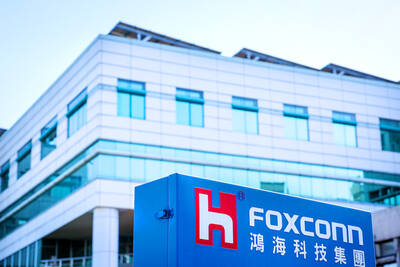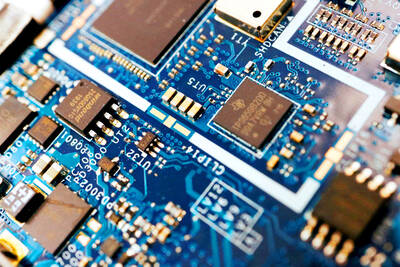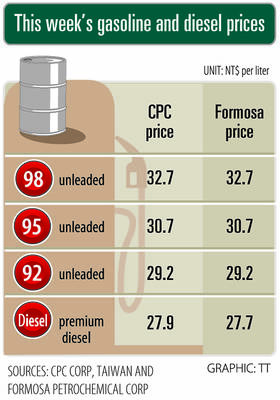United Microelectronics Corp (UMC, 聯電) yesterday posted its weakest quarterly net profit in five quarters, as chip demand for most applications slackened amid a longer-than-expected inventory correction.
Net profit declined 18.3 percent annually to NT$16.18 billion (US$526.6 million) in the first quarter of this year from NT$19.81 billion in the same quarter last year and 15.1 percent from NT$19.07 billion in the previous quarter, the world’s third-largest foundry service provider said.
Earnings per share dropped to NT$1.31 from NT$1.61 a year earlier and NT$1.54 a quarter earlier.

Photo: Lam Yik Fei, Bloomberg
Gross margin dropped to 35.5 percent from 42.9 percent in the previous quarter and 43.4 percent a year earlier, marking the lowest level in seven quarters.
“In the first quarter of 2023, our business was impacted by sluggish wafer demand as customers continued to digest elevated inventory levels,” UMC copresident Jason Wang (王石) told investors at an online conference yesterday.
The business outlook remains bleak, as the Hsinchu-based chipmaker said this year would be a “very challenging year.”
“The market will be much weaker than we anticipated. Recovery is much slower than we expected,” Wang said.
UMC said the foundry sector would see revenue declining by a high-single-digit percentage from a year earlier — worse than forecast three month earlier, when it expected a mid-single-digit percentage decline.
The global semiconductor industry would see a mid-single-digit percentage decline in revenue this year, rather than its previous prediction of a low-single-digit percentage drop, UMC said.
“Given the weaker-than-expected end-market environment, we see the pace of inventory digestion move slower than expected. We have not seen any signs of strong recovery for the second half yet,” although the company’s revenue hit the bottom last quarter, Wang said.
For this quarter, UMC expects wafer shipments to be flat from last quarter.
Demand outlook for all segments, including PCs, and communication and consumer electronics, would also be flat sequentially, it said.
Wang said that replenishing demand for automotive chips peaked last quarter, after two quarters of robust growth.
Automotive chips, which accounted for 17 percent of the company’s revenue last quarter, would be a major growth driver in the long term, UMC said.
Gross margin is expected to stabilize at about 35 percent this quarter, with average selling prices remaining flat from last quarter, the chipmaker said.
Overall factory utilization would be slightly above 70 percent, little changed from last quarter, it said.
The utilization of 28-nanometer technology would gradually rise to above 90 percent in the second half of this year, Wang said.
UMC said it uses 28-nanometer technology to make OLED driver ICs, TV chips and Wi-Fi 6 chips, adding that the technology contributed 26 percent to its revenue last quarter.
UMC said it would keep its capital budget at US$3 billion this year, but is ready for potential downward adjustments in accordance with market demand.
The chipmaker said that its new factory in Tainan, dubbed P6, would increase production next quarter.
The fab would produce chips under long-term supply agreements with customers, UMC said.

Hon Hai Precision Industry Co (鴻海精密) yesterday said that its research institute has launched its first advanced artificial intelligence (AI) large language model (LLM) using traditional Chinese, with technology assistance from Nvidia Corp. Hon Hai, also known as Foxconn Technology Group (富士康科技集團), said the LLM, FoxBrain, is expected to improve its data analysis capabilities for smart manufacturing, and electric vehicle and smart city development. An LLM is a type of AI trained on vast amounts of text data and uses deep learning techniques, particularly neural networks, to process and generate language. They are essential for building and improving AI-powered servers. Nvidia provided assistance

DOMESTIC SUPPLY: The probe comes as Donald Trump has called for the repeal of the US$52.7 billion CHIPS and Science Act, which the US Congress passed in 2022 The Office of the US Trade Representative is to hold a hearing tomorrow into older Chinese-made “legacy” semiconductors that could heap more US tariffs on chips from China that power everyday goods from cars to washing machines to telecoms equipment. The probe, which began during former US president Joe Biden’s tenure in December last year, aims to protect US and other semiconductor producers from China’s massive state-driven buildup of domestic chip supply. A 50 percent US tariff on Chinese semiconductors began on Jan. 1. Legacy chips use older manufacturing processes introduced more than a decade ago and are often far simpler than

STILL HOPEFUL: Delayed payment of NT$5.35 billion from an Indian server client sent its earnings plunging last year, but the firm expects a gradual pickup ahead Asustek Computer Inc (華碩), the world’s No. 5 PC vendor, yesterday reported an 87 percent slump in net profit for last year, dragged by a massive overdue payment from an Indian cloud service provider. The Indian customer has delayed payment totaling NT$5.35 billion (US$162.7 million), Asustek chief financial officer Nick Wu (吳長榮) told an online earnings conference. Asustek shipped servers to India between April and June last year. The customer told Asustek that it is launching multiple fundraising projects and expected to repay the debt in the short term, Wu said. The Indian customer accounted for less than 10 percent to Asustek’s

Gasoline and diesel prices this week are to decrease NT$0.5 and NT$1 per liter respectively as international crude prices continued to fall last week, CPC Corp, Taiwan (CPC, 台灣中油) and Formosa Petrochemical Corp (台塑石化) said yesterday. Effective today, gasoline prices at CPC and Formosa stations are to decrease to NT$29.2, NT$30.7 and NT$32.7 per liter for 92, 95 and 98-octane unleaded gasoline respectively, while premium diesel is to cost NT$27.9 per liter at CPC stations and NT$27.7 at Formosa pumps, the companies said in separate statements. Global crude oil prices dropped last week after the eight OPEC+ members said they would